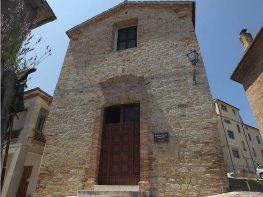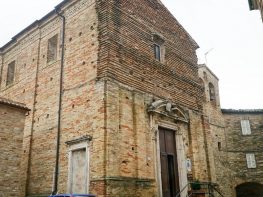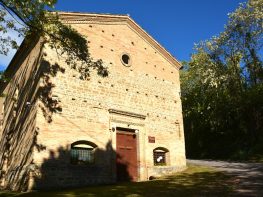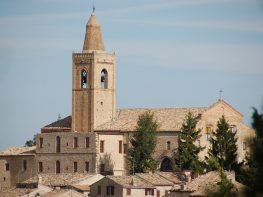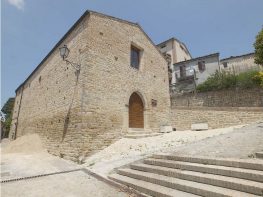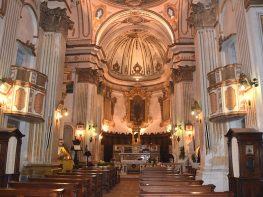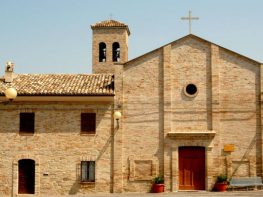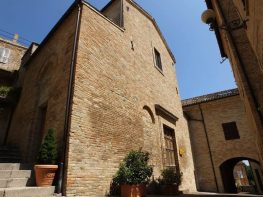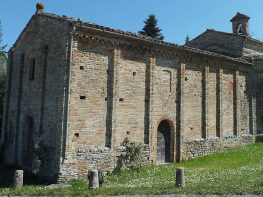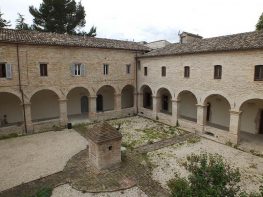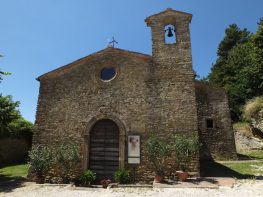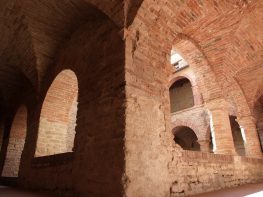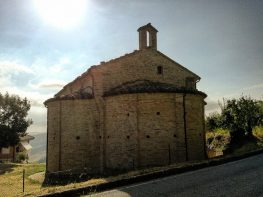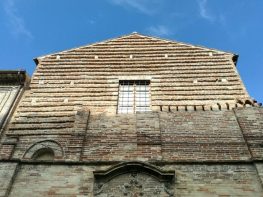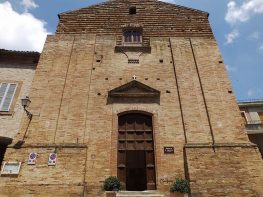La chiesa fu eretta per iniziativa dell’arcivescovo di Fermo Alessandro Borgia il quale, nel 1741, durante la visita pastorale condotta al paese, convocò i priori delle confraternite del S.mo Rosario e del S.mo Sacramento e impose loro di edificare un nuovo luogo di culto con il titolo della Madonna della Misericordia. Le due confraternite utilizzavano, infatti, per le loro attività associative una chiesetta intitolata anch’essa alla Madonna della Misericordia, che però risultava troppo angusta per accogliere entrambi i pii sodalizi così nel 1759 fu ultimata la nuova chiesa e nel 1798 venne consacrata. Esternamente la facciata ha forme barocche con mattoni a vista e lateralmente sono presenti contrafforti che rafforzano tutta la struttura sui quali si aprono delle finestre. Date le forme architettoniche molto simili ad altre due chiese, si suppone sia attribuibile all’architetto Gaetano Maggi. All’interno vi è un’unica navata con due cappelle per lato e le pareti sono ritmate da elementi architettonici decorativi; complessivamente sono presenti cinque cappelle con annessi altari e due confessionali. Le pregevoli opere d’arte che adornano l’interno appartengono ad insigni artisti quali Filippo Ricci ed Antonio Liozzi. Di Ricci sono conservate due tele ai lati del presbiterio con cornici ornate di stucchi in stile rococò, raffiguranti: il primo, la Madonna della Misericordia, Francesco d’Assisi e San Giovanni Battista; mentre il secondo, San Giovanni Evangelista e san Giovanni Nepocumeno. La controfacciata presenta strutture lignee con pitture di Antonio Liozzi, che ritraggono la Madonna col Bambino, San Giuseppe e Santa Caterina d’Alessandria. Nella chiesa è inoltre conservato un antico affresco proveniente da santa Maria di Montorso e, dietro l’altare maggiore è collocata la tela raffigurante la Madonna del Rosario con i Santi Domenico e Caterina da Siena. L’organo dipinto risale alla metà del XVIII secolo e viene attribuito a Giuseppe Attilli.
The church was erected on the initiative of the then Archbishop of Fermo, Alessandro Borgia. In 1741, during a pastoral visit to the town, the Archbishop met with the priors of the Santissimo Rosario and Santissimo Sacramento brotherhoods and ordered them to build a new place of worship with the name Madonna della Misericordia, or Madonna of Mercy. The two brotherhoods used a small church also named Madonna della Misericordia but this was too cramped to hold both devout brotherhoods, so the new church was completed in 1759 and in 1798 it was consecrated. The external façade is in the Baroque style with open brickwork and lateral buttresses that reinforce the whole structure, on which can be found windows. Given the similarity in architectural style between this and two other churches, the design can be attributed to Gaetano Maggi. Inside, there is one single nave with two side chapels. The walls have regular decorative architectural elements; there are five chapels with altar annexes and two confessionals. The prestigious works of art that adorn the interior belong to respected artists such as Filippo Ricci and Antonio Liozzi. There are two Ricci canvasses preserved at the sides of the presbytery, with ornate stucco frames in rococo style. The first portrays the Madonna of Mercy, St Francis of Assisi and St John the Baptist, while the second St John the Evangelist and St John Nepomucene. The counter- façade has wooden structures with paintings by Antonio Liozzi which portray the Madonna with Child, St Joseph and St Catherine of Alexandria. An antique fresco of St Mary of Montorso is also preserved in the church; behind the main altar the canvas of the Madonna of the Rosary with St Dominic and St Catherine of Siena can be found. The painted organ dates back to the middle of the 18 th century and can be attributed to Giuseppe Attili.
L’eglise a été érigée par l’initiative de l’Archevêque de Fermo Alessandro Borgia. Ce dernier lors d’une visite pastorale dans cette ville en 1741 avait convoqué les Prieurs des confréries du Très Saint Rosaire et du Très Saint Sacrement. Il leur ordonna d’ édifier un lieu de culte dédié à la Madonne de la Misericorde. Les deux confréries utilisaient en effet, pour leurs activités associatives une petite chapelle dédiée également à la Madonne de la Misericorde; toutefois elle était étroite et ne permettait pas aux pieux adhérents des confréries aux offices. Ainsi en 1759 la nouvelle église fu achevée et en 1798, elle a été consacrée. Extérieurement la façade a des formes baroques avec des briques apparentes; et latéralement on y trouve des contreforts sur qui renforcent toute la structure mais permettent aussi l’ouverture des fenêtres. Etant donné les formes architectoniques, très sembles à deux autres églises, l’on suppose qu’elle a été réalisée par l’architecte Gaetano Maggi. À l’intérieur on y trouve une seule une seule nef avec deux chapelles de chaque côté et les murs sont ornés d’éléments décoratifs; au total on y trouve cinque chapelles avec des autels annexes et deux confessionnaux. Les précieuses oeuvres d’art qui ornent l’intérieur appartiennent aux artistes renommés comme Filippo Ricci et Antonio Liozzi. L’on conserve de l’artiste Ricci les deux toiles qui sont aux côtés du presbytère avec des cadres décorés de stucs en style rococo; qui représente pour le premier; la Madonne de la Miséricorde, Saint François d’Assise et Saint Jean Baptiste; le second en revanche; Saint Jean l’Evangeliste et Saint Jean Nepocumeno. La contre-façade présente des structures en bois avec des peintures d’Antonio Liozzi, qui dépeignent la Madonne avec le bébé, Saint Joseph et Sainte Catherine d’Alessandria. À l’intérieur de l’église est conservée une fresque ancienne de Santa Maria di Montorso et, derrière l’autel majeur se trouve une toile représentant la Madonne du Rosaire avec les Saints Dominique et Catherine de Sienne. L’orgue peint remonte à la moitié du XVIII siècle et est attribué à Giuseppe Attilli.
Diese Kirche, in der sich heute das Museo Civico Archeologico befindet, in dem die hellenischen Artefakte aus der Gegend “La Cuma” aufbewahrt werden, trägt den Namen “Chiesa del SS”. Crocefisso (die Kirche des Allerheiligsten Kruzifix). Zuerst im XII Jahrhundert gebaut und dann im Jahre 1662 wieder aufgebaut, war ursprünglich St. Flavian, dann St. Mary of Succor gewidmet. Es liegt etwas außerhalb des Stadtzentrums an der Straße, die nach Ortezzano führt. Seine Struktur ist im romantischen Stil, einfach und unprätentiös, mit großen Blöcken aus Tuffstein gebaut, ähnlich wie im archäologischen Bereich. Im Jahre 1299 existierte die Kirche an derselben Stelle, an der sie heute steht und wurde dann San Flaviano genannt. Es ist wahrscheinlich, dass dies die primitive Pfarrkirche der alten Burg von Monte Rinaldo war und dass sie die wichtigste der Siedlung blieb, bis die Erweiterung der Burgmauer mit dem Bau der neuen Pfarrkirche von San Leonardo. Am 24. April 1744, anlässlich der Missionen, wurde das Bild der Madonna hinzugefügt, die Kirche nahm den Namen Maria Santissima del Soccorso (Heilige Frau des Beifalls) an. Im Laufe der Jahrhunderte wurde es jedoch gleichgültig mit allen drei Titeln identifiziert: Santissimo Crocifisso, Maria Santissima del Soccorso und San Flaviano, deren Erinnerung erhalten bleibt. Im Inneren befanden sich vier Altäre: der Hauptaltar des Patronats der Stadt, die Altäre des Hl. Dominikus und die Verkündigung der Heiligen Jungfrau und schließlich die der Heiligen Jungfrau von Loreto. Im XIX. Jahrhundert unterlag die Kirche keinen bedeutenden baulichen Veränderungen, aber die Anzahl der Altäre wurde auf zwei reduziert: eine Stuckverzierung im Barockstil und eine andere in Holzschnitzerei. Heutzutage wird es sowohl in der üblichen Verwendung als auch in offiziellen Dokumenten als Chiesa del Santissimo Crocefisso (die Kirche des Allerheiligsten Kruzifixes) bezeichnet.





























